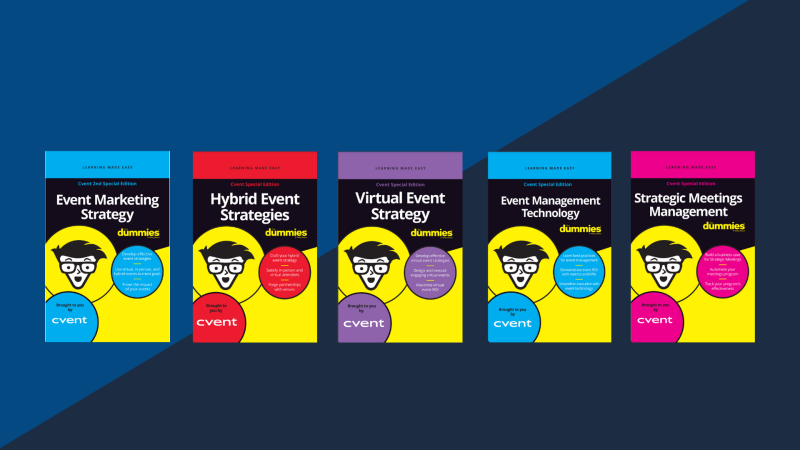By definition, a hybrid event needs to serve the needs of two audiences: those who want an in-person experience, and those who prefer to attend virtually. And like any good marketing strategy, executing an effective hybrid event marketing strategy starts with acknowledging that these audiences likely have different needs and motivations.
What attendees want from an in-person event
Attendees considering an in-person experience may place a higher premium on face-to-face networking and relationship building elements of the event. They may be more familiar with your organization and its offerings, searching out a more tactile or in-depth experience with your products, trainers, or sales teams. As a result, you may consider programming more tied to immediacy of action or decision-making for this audience (we touch more on this in our post dedicated to the hybrid content building block).
Or perhaps your in-person audience - having been home-bound and on Zoom meetings for months - may simply be motivated by a change of scenery and routine – as long as they know the venue and event will be safe. Understanding the experience and value these attendees seek will be critical to everything from your programming and content strategy, how you may price the in-person experience, and the registration experience itself.
What attendees want from a virtual event
Attendees considering your virtual event likely have different motivations. For starters, they may be more safety-concerned, budget, and/or time-constrained than your in-person segment. They also may be less familiar with your organization and offerings and want to use the event as a way to get an overview of your organization’s mission and offerings.
Programming for this audience may be more likely to be tied to exploration and research. Whatever their motivations, virtual attendees still want useful, engaging, and well-produced content. They still want to learn, be connected to peers, and feel like they are part of something substantial, not a separate less-than experience
Organizations that reap the most value from their hybrid events will acknowledge these differences as they plan, promote and target personalized offers in their pre-event marketing – to both audiences.
Matching the right attendee to the right experience
As you develop your marketing plan for a hybrid event, the hybrid nature of your event is one of its biggest selling points. The flexibility to attend in-person or virtually should be prevalent in all your event’s inbound and outbound communications, and your event website. But the reality is that your hybrid event likely needs strong in-person attendance to succeed. So how do you decide who to target or when to offer the in-person message vs. a virtual one?
Making an educated guess
The reality is that you won’t know for certain who wants to attend in person and who wants to attend virtually. However, you can make some educated guesses. For example, in your email invitations, you may want to lead with an in-person message to existing customers or those who have attended your in-person events in the past. In addition, you may want to identify prospects that are highly engaged or are farther down the sales process. Some organizations, cognizant of travel and budget restrictions, are inviting prospective attendees within a certain radius of the venue so that the attendees can easily “commute” to the event and then back home at night.
Leveraging Sales and Membership teams
Another great approach is to leverage your Sales or Membership teams who likely know best who your highest-value accounts and contacts are. Activating these teams via email or calling campaigns, supported by the right messaging and in-person value propositions can be a great way to get the highest value audience to the in-person experience.
Virtual events are more accessible for attendees
While nothing can match the deep level of engagement enabled through in-person experiences, your hybrid event’s virtual audience is also very valuable and requires similar thoughtfulness. Taking full advantage of the reach enabled by virtual is a key benefit of a hybrid event. Throughout 2020, we have seen virtual events garner 6x – 10x the number of registrations of equivalent in-person events. The reasons are obvious.
Target lightly engaged prospects
With a lower time and cost commitment, a virtual event can reach segments that, while interested in your message of offerings, aren’t yet ready for the cost and expense that an in-person experience requires. For those reasons, unengaged or lightly engaged prospects may be good candidates to lead with a virtual event message.
Target higher-level positions
You should also consider adding higher-level titles (VPs and C-suite titles) to the virtual-first message. These individuals may truly be interested in what you can do for their organizations, but who are too busy to spend days away from work that an in-person experience requires.
Target people from the same company
Finally, a virtual option may be an effective way to bring more people from the same organization to your event. While budget or residual health concerns may mean one or two key decision-makers from an account may attend in person, a virtual option enables their extended team or other key stakeholders to participate virtually.
One event – two experiences™
Even in the face of the most sophisticated segmentation and messaging strategy, your audience will ultimately determine for themselves whether an in-person or virtual experience is right for them. Your job is to give them the information they need to make that decision, and the resulting registration paths to convert them from interested to registered.
Build an engaging event website
Let’s start with the event website. As your marketing mix delivers interest and eyeballs to your event website, that website must give each audience the key logistical, agenda, programming, and price information they need to make that decision. There is no getting around the fact that hybrid events add complexity to the attendee journey.
Compare the virtual event vs in-person event experience
While prospective attendees always had to determine what session, they wanted to attend or what booths they wanted to visit, a hybrid event now adds the virtual vs in-person layer to those decisions. What will my experience look like if I attend in-person? Where is the venue and what does it look like? What are the venue’s safety and cleanliness policies? What networking or training opportunities will there be? Will there be any content exclusively available to in-person attendees? And, of course, what are the costs associated with each experience?
Consistency is key
The event website needs to deliver all of this information (and more) for both the in-person and virtual attendee, and it should do it in a way that the event feels like one event. Having a consistent brand look and feel as visitors are reviewing their in-person and virtual options helps both audiences feel like, whatever choice they make, they will be participants in a shared, valuable experience.
Turning visitors into registrants
For many events, configuring multiple registration paths to ensure a personalized experience was already a challenge. From an event marketing perspective, the registration process is where the conversion happens, and ensuring customers, prospects, VIPs, exhibitors, and others were provided the appropriate registration experience, only showing the correct agenda, logistics, pricing, etc. was vital.
As we touched on earlier, hybrid only adds to this complexity. Your hybrid event registration software must be powerful and flexible enough to handle the necessary configuration. As one data point, for the upcoming Hybrid Cvent CONNECT conference planned for August 2021, we are expecting over 30 unique registration types.
Creating personalized registration paths
Let’s look at a simplistic example: An attendee that opts for an in-person experience will need to see details on the venue, the in-person programming or agenda items - including those that may be exclusive to the in-person experience - and of course the registration fee.
They are also likely to need to arrange housing and travel through their registration experience. Of course, the attendee that opts for the virtual experience does not need details about the venue. Nor do they need housing and travel information. They need to know the content and programming options, how and when they will consume that content, and their registration fee (if any).
Offering multiple, personalized registration paths will help your attendees find and register for the right experience and will help event marketers and planners ensure that maximize hybrid event attendance. It will also help your internal teams manage the logistics needed to ensure both audience access and navigate the event smoothly.
The hybrid event marketing bottom line
Marketing a hybrid event is not dissimilar from marketing a virtual or in-person event. Many of the basics are the same. However, once you’ve decided to go hybrid, your audience complexity increases. Managing that complexity so that you get the right attendees into the right experience is key to hybrid event success.
- Craft a hybrid event invitation strategy that leverages the deep engagement of in-person with the undeniable reach of virtual
- Ensure your hybrid event’s value proposition, brand identity, and event website delivers on the “One Event, Two Experience” promise
- Don’t underestimate the need for a highly configurable registration experience. Delivering a personalized registration in the face of Hybrid audience complexity will help you drive more attendance and engagement
Key Elements of Hybrid Meetings
- Intro to 6 key elements: Learn about the tremendous improvement in virtual event technology
- Marketing: Targeting different audiences with the right experience
- Venue: Partnering with your venue to deliver safe onsite experiences
- Content: Producing and delivering content for in-person and virtual audiences







